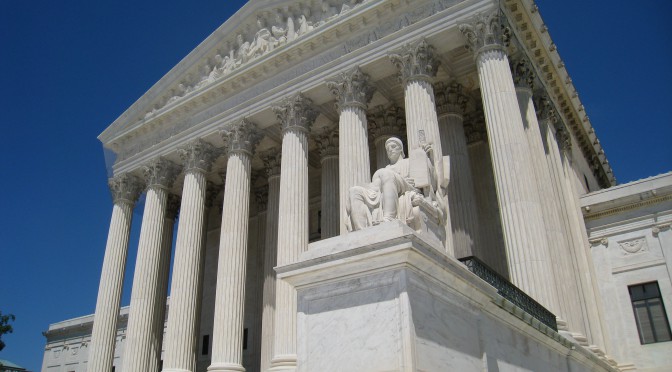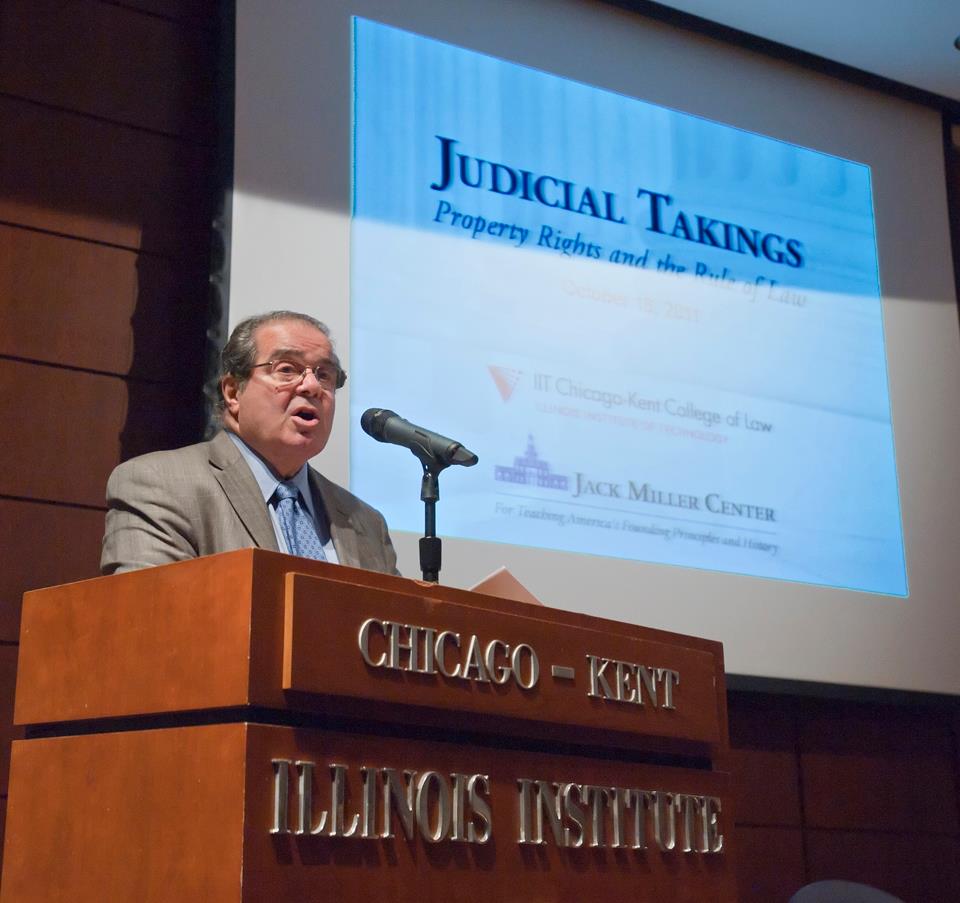Post by Vinay Harpalani, J.D., Ph.D., Associate Professor of Law at Savannah Law School. Follow him on twitter at @VinayHarpalani.
With Justice Antonin Scalia’s passing on February 13, the U.S. Supreme Court is at a crossroads. America is also currently in the midst of a contentious Presidential primary season, particularly on the Republican side. In the coming months we will witness an unprecedented confluence of judicial and electoral politics. Not since 1988 has a Supreme Court Justice been confirmed during presidential primary season, and not since 1940 has a Justice been both nominated and confirmed in an election year. The Supreme Court vacancy looms even larger because Scalia was such an influential jurist, capturing the public’s imagination like no other. Quite fittingly, the impending battle over Scalia’s replacement itself leads to an intertwined discourse on constitutional law and politics.
Republicans immediately declared their intention to block any nominee put forth by President Barack Obama to replace Scalia. GOP Presidential candidates, from frontrunner Donald Trump to Senators Ted Cruz and Marco Rubio, have called for a moratorium on appointing a new Justice until the next President is in office. Senate Majority Leader Mitch McConnell, along with many other Republican members of Congress, has echoed this sentiment. Obama has declared that he will nominate a suitable candidate and expects his nominee to receive a floor vote in the Senate.
The public dialogue on this arising confrontation pits constitutional values against political gains. For example, earlier this week, when discussing the Supreme Court vacancy, Democratic Presidential candidate Hillary Clinton suggested that Republicans who “would put politics over the Constitution” are “disgraceful.” But our Founders designed the Constitution to deal with political strife. In this controversy, the Constitution cannot be separated from politics.
Article II, Section 2, Clause 2 gives the President the authority, “with Advice and Consent of the Senate,” to “appoint … Judges of the supreme Court[.]” But there is no mechanism to compel the Senate to actually provide such consent for any given nominee, or even to consider the matter. Legislatures are inherently inefficient, even when they do not intend to be, and while the Constitution enumerates the powers of Congress, it does not require either the House or the Senate to act on those powers.
Judicial appointments are a hallmark example. We have seen past instances where the President is of one party and the Senate is controlled by the other, and judicial confirmations come to a standstill. Although the stakes are much higher with a Supreme Court vacancy, this does not create any new constitutional obligation for either the President or the Senate.
There is also no constitutional crisis or breakdown here. The Supreme Court can function with eight Justices, even with its current ideological divide. It is Congress, not the Constitution, that determines the number of Justices on the Court. In the past, the Court has had six, seven, or ten Justices. The Court’s rules provide for a quorum of six Justices, so Scalia’s vacancy need not be filled for it to hear and decide cases.
Additionally, many Supreme Court decisions are unanimous—a fact often missed in the public conversation about the Court. In its 2014-15 term, over 60 percent of the Court’s rulings were unanimous, and less than 20 percent of its cases were decided 5-4. Although the most noteworthy cases are often close splits, ideological decisions are the exception rather than the norm. Thus, the Court will not be gridlocked on most cases.
Even with some cases decided 4-4, the judiciary will continue to function. The Circuit Courts of Appeals’ rulings will simply be affirmed, leaving unresolved Circuit splits in place with no higher binding precedent. This may create problems for the Supreme Court’s legitimacy and public image. Also, over the long term, a series of Circuit splits on matters of federal law could undermine uniformity and constitutional principles such as federal supremacy. However, that would take many years, and the impasse over Scalia’s vacant seat is not likely to last long enough for it to occur.
In the unlikely event that President Obama sued the Senate Judiciary Committee for breaching its constitutional duty, courts would almost certainly rule that the case poses a nonjusticiable, political question. This means that any dispute arising over the nominee’s confirmation would have to be resolved not by the courts, but in the political theater. Essentially, the political question doctrine puts the Constitution and politics on the same plane, allowing the latter to resolve controversies involving the former. Even without a lawsuit, the same principle applies to this controversy.
How will it play out? Regardless of who President Obama chooses to nominate, Republicans will probably continue obstructionist rhetoric and hold up the nomination process for several months—while both parties select their presidential candidates. During this period, each party will focus mainly on appealing to its base. The Supreme Court vacancy will continue to be a prominent issue in both campaigns. A debate over Scalia’s replacement might affect how the GOP views its 2016 presidential nomination. In recent weeks, establishment Republicans had indicated that they might have to choose among outsiders Donald Trump and Ted Cruz, with most preferring the former. Some of them reasoned that even if Trump lost the general election, he would be one-and-done—whereas Cruz could gain momentum for future Presidential runs. With Scalia’s passing, the stakes are higher: they directly involve the ideological future of the Supreme Court. Unless they believe Trump can really win the general election, Republicans have even more incentive to rally behind an establishment candidate such as Rubio or Governor Jeb Bush.
In any case, after the contentious Republican primary season, the political calculus around the Supreme Court vacancy may change. To be successful in November’s general election, Republicans will need to extend beyond their conservative base. Moderate and independent voters may be put off if Republicans continue to stall, particularly in light of the fact that Democrats will politicize the issue just as much on the other side. In the past, the judiciary has not usually been a major campaign issue, but it could become more prominent because of the stakes here.
Moreover, Senate Republicans, who will determine the fate of Obama’s nominee, hold 24 of the 34 Senate seats up for election in November. These include seats in Florida, Ohio, Pennsylvania, Illinois, Iowa, Wisconsin, and New Hampshire—all states that Obama won in 2012. The GOP will have to gauge the political atmosphere before determining exactly how to proceed. In fact, Senate Judiciary Committee Chair Chuck Grassley has already gone back and forth on the committee’s future course. And if President Obama chooses someone who is well-credentialed and politically moderate, the GOP may feel pressure to at least allow a Senate vote on the nominee.
But voting Obama’s nominee down on the floor could also impact Republicans in November’s election, particularly if the GOP cannot easily oppose the nominee on merit or on ideological grounds. For example, Judge Sri Srinivasan was confirmed 97-0 to the D.C. Circuit Court of Appeals in 2013, by a Republican-controlled Senate. Srinivasan, who would be the first Asian or South Asian American Justice, worked in the Solicitor General’s office for both President George W. Bush and President Obama’s administrations and has not taken public positions on any hot button social issues. Another possibility is the Eighth Circuit’s Jane Kelly, who is also known as a moderate and was confirmed 96-0 by the Senate in 2013. Judge Aldalberto Jordan of the Eleventh Circuit was confirmed 94-5 in 2012 and would also force the GOP to block a Latino judge. In making his choice, President Obama will try to maximize pressure on vulnerable Republican Senators.
Can this work for the President? Republicans have stalled and filibustered many of his lower court nominees without much political consequence. Nevertheless, this delay would be unprecedented in length and significance, and it would not ultimately succeed unless the GOP wins the Presidency. Both parties will attempt to mobilize their constituencies around the judiciary more than ever before, ultimately determining not only the Presidency and the Senate, but also the ideological future of our highest Court. Regardless of the outcome, we can be sure that, unless the two parties manage to reach a compromise, the Supreme Court will take a more prominent role in this Presidential campaign season than ever before.


